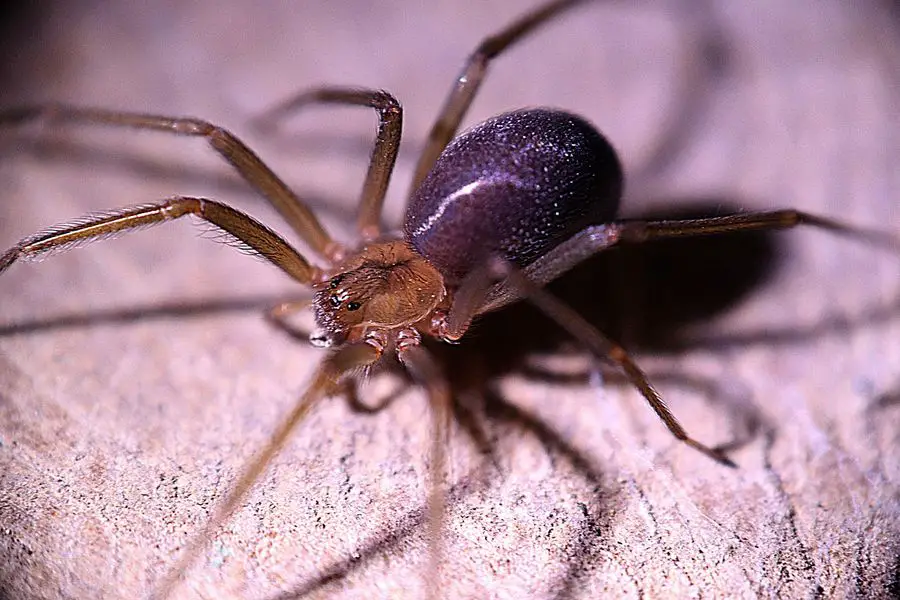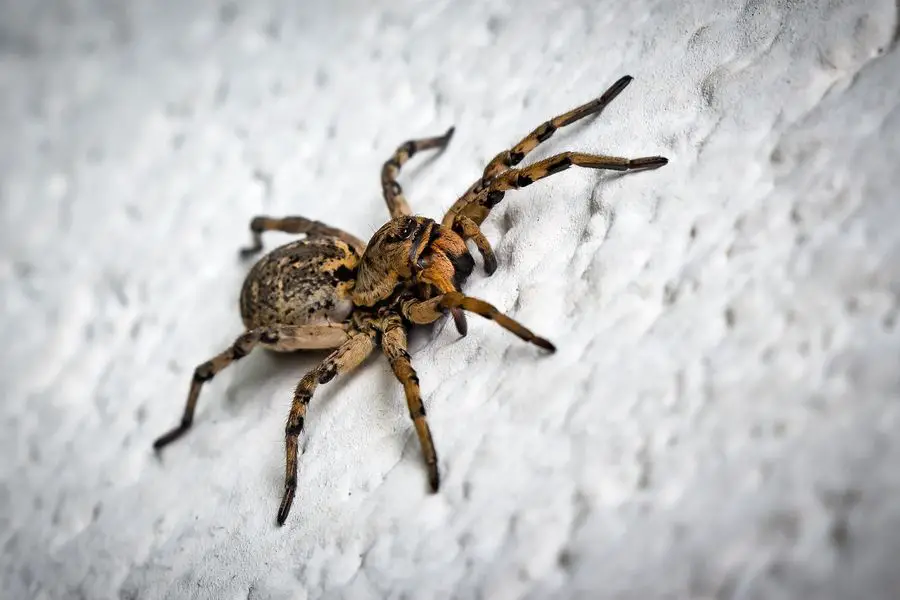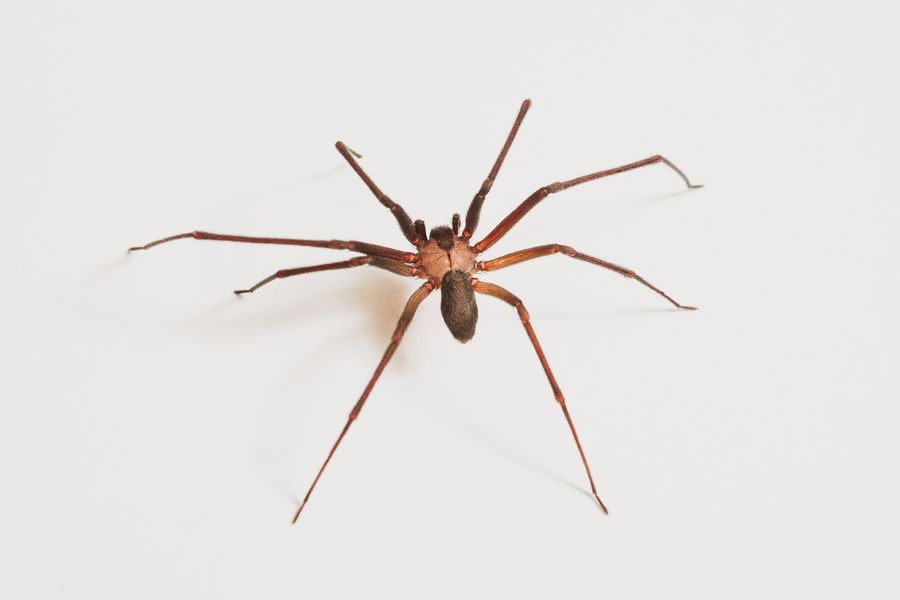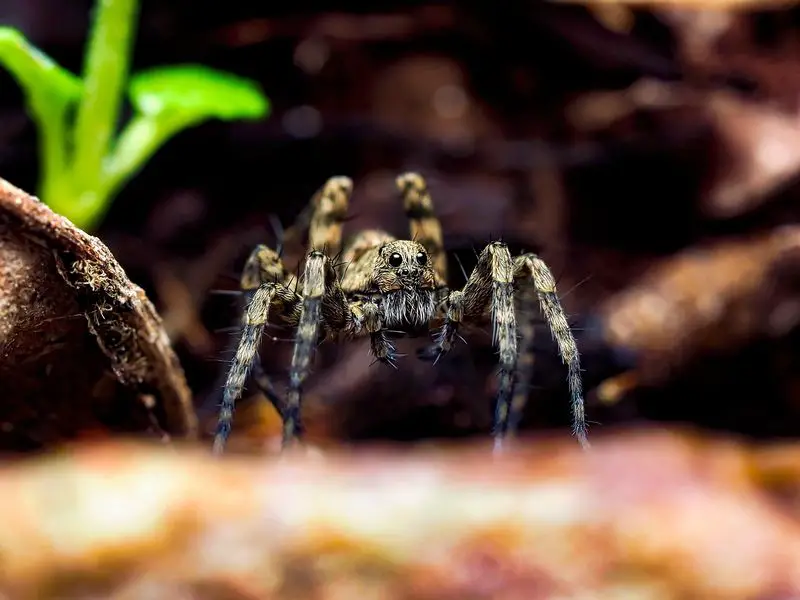Spiders often evoke fear and curiosity, especially when it comes to species like the wolf spider and the brown recluse.
While both can be mistaken for one another, they have distinct physical traits, behaviours, and levels of danger to humans.
The brown recluse is known for its venomous bite, which can cause serious skin reactions, while the wolf spider, despite its intimidating appearance, is relatively harmless.
This article will help you differentiate between these two spiders by examining their morphology, habitats, behaviour, and venom effects.
Additionally, we will dispel common myths and provide practical tips on prevention and control. Understanding these spiders can help reduce fear and promote coexistence with these beneficial arachnids.
Main Takeaways
- Key Identification Traits: Brown recluse spiders are small, brown, and have a distinct violin-shaped mark, while wolf spiders are larger, hairy, and have different eye arrangements.
- Morphology: Brown recluse spiders have a fragile build with six eyes in a triangular pattern, whereas wolf spiders are sturdier, often larger, and have eight eyes in two rows.
- Habitat & Distribution: Brown recluses are mainly found in North America, preferring dark, secluded areas. Wolf spiders are more widespread globally and are commonly found in grassy fields and near water.
- Behavioural Differences: Brown recluse spiders are shy and nocturnal, relying on webs for occasional prey capture. Wolf spiders are active hunters with strong maternal instincts, carrying their young on their backs.
- Venom & Bite Effects: Brown recluse bites can cause serious necrotic wounds, while wolf spider bites are mild and comparable to bee stings.
- Prevention & Control: Decluttering, sealing entry points, and using natural repellents (e.g., essential oils, and vinegar) can help deter brown recluses.
- Cultural Misconceptions: Both spiders are often misrepresented as more dangerous than they truly are, leading to unnecessary fear and misidentification.
Key Identification Traits
It is not difficult to distinguish between a wolf spider and a brown recluse. These two spiders are extremely different in anatomy, poison, habitat, and behaviour towards humans and prey.
The Brown Recluse Morphology
This spider is particularly small, with a body length ranging from 6 to 20 mm (0.23 to 0.78 inches).
It is easily identifiable by its morphological aspect and the characteristic violin-shaped mark on its back.
Adult females of brown recluse are 7–12 mm in body length, but they can look larger because they possess long legs. The males are smaller, averaging 6 to 8 mm. Males can easily be recognised because they possess big pedipalps. Pedipalps are a pair of sensory and manipulative appendages found in arachnids, including spiders and scorpions. Pedipalps are near the mouth, just in front of the first pair of legs. In males, the pedipalps become enlarged and swollen at the tips, forming a sperm transfer organ.
The brown recluse has a uniform brown colour and a slim body. One of the main characteristics is that brown recluse spiders have only six eyes in a triangular shape.
Brown recluses have a weak build. Their legs can often be injured while trying to catch prey, and because they cannot regenerate their legs, they often die after a predation that goes wrong.
However, although they are very fragile, brown spiders can also be very resistant to hunger and thirst. Brown spiders stuck in traps or boxes have been reported to have managed to live for up to 10 months.
Because Brown recluses can be fragile, they have developed a very solitary and recluse life (from which the name comes from). But because they are also very resilient, they can be found in big numbers and can live for many years. These characteristics also shaped their predatory behaviour and feeding habits.

Photo By: Francisco Corado Rivera
What Spiders Can Look Like Brown Recluse Spiders?
Several spiders can resemble the brown recluse spider (Loxosceles reclusa), but they are not as dangerous:
- Wolf Spiders (Family Lycosidae)
- Teddy Bear or Fur-Legged Spiders (Family Theridiidae)
- Lynx Spiders (Genus Oxyopes)
- Brown Widow Spiders (Latrodectus geometricus)
- Hobo Spiders (Tegenaria agrestis)
- Cellar Spiders (Family Pholcidae)
Wolf Spiders Morphology
Wolf spiders belong to the family Lycosidae, which has more than 2400 species and is present worldwide. Because of this great number of species, there are many differences in morphology within the family.
These spiders can range in body size from very large to very small. However, they are known for being normally large, reaching up to 4 cm, and having a hairy body.
Some researchers have tried to propose common characteristics within the species. They found:
- The tibial apophysis, a small, hardened projection found on the tibia of the male spider’s pedipalp, is absent.
- The eyes are positioned 4 small anterior and 4 large in the posterior area.
- Females and male spiders do not have a strong dimorphism. However, females are usually slightly bigger.
- The most notorious characteristic is that females can carry spiderlings on their top and the egg sac under their abdomen.

Photo By: Robert Balog
Wolf Spider Distribution And Habitats
Wolf spiders are present all over the world, and they exhibit a markedly different set of habitat preferences compared to brown recluses.
Wolf spiders’ wide global distribution reflects their adaptability to diverse environments, from temperate regions to tropical climates. They are primarily found in various open areas, such as grassy fields and gardens. Unlike brown recluses, wolf spiders do not spin webs; instead, they are predators that utilise their exceptional eyesight to hunt prey actively.
Many species of wolf spiders are present in so-called riparian areas, ecosystems found along the edges of rivers, lakes, and other water bodies. These areas typically are rich in vegetation, making them important habitats for many species with abundant prey and shelter. The moist conditions and dense plant life in riparian zones provide excellent hunting grounds for wolf spiders, active hunters who rely on their speed and vision rather than webs to catch prey. Some members of this family have been recorded as hunting on the water’s surface, and almost all of them belong to the genus Pirata.
Brown Recluse Distribution
Brown recluse spiders mostly live in North America. In the United States, you can find them mainly in the southern, western, and midwestern parts of the country.
However, a well-known Brown Recluse spider, Loxoscelles Rufescens, lives in the Mediterranean, especially in Italy.
Where Do Brown Recluse Spiders Hide?
They tend to favour dark, secluded spaces. When indoors, they are often found in closets, attics, and corners, remaining hidden during daylight hours. However, some have been recorded sunbathing in bright areas; this is probably mostly females nurturing the eggs. Outdoors, they gravitate towards woodpiles, sheds, or areas that offer concealment and protection from disturbances.
As already said, brown recluses build webs. However, these webs are irregular and usually low to the ground. In houses, these spiders build webs in areas away from disturbances. Outside webs are built in areas such as wood storages, behind shutters, and underneath wooden patios. Unless recently made, the webs of brown recluse spiders do not seem to be able to retain prey, but they are able to hold the prey for a sufficient period of time so the spider can be aware of its presence.
Behavioural Differences Between Brown Recluse and Wolf Spiders
The behavioural differences between wolf spiders and brown recluse spiders are significant. They exhibit distinct behaviours that influence their interactions with humans and their environments.
Brown recluse spiders are characterised by shy behaviour, often retreating when disturbed. This tendency, coupled with their nocturnal nature, results in fewer direct interactions with humans. However, their preference for habitats near human dwellings increases the risk of a brown recluse bite.
The recluse avoids confrontation, while the wolf spider can be defensive if provoked. Additionally, wolf spiders exhibit strong maternal instincts, carrying their egg sacs with them, a behaviour absent in recluse spiders.
Wolf spiders are active hunters, displaying more aggressive tendencies. They are diurnal, actively seeking prey during daylight hours. Unlike the brown recluse, wolf spiders do not rely on webs to catch prey; instead, they leverage their keen vision and agility to hunt. This active hunting behaviour means wolf spiders are typically found outdoors, particularly in grassy areas and near water sources.
What Do Brown Recluse Spiders Eat?
When attacking prey, the brown recluse is very quick, and then she retreats and will only eat the prey when she needs it.
Brown recluse spiders feed on a variety of insects and arthropods, but they prefer dead prey. They can eat freshly killed prey, prey killed months before, or carcasses of insects killed by insecticides or predators.

Photo By: Timothy Dykes
What Animal Eats Brown Recluse Spiders?
Due to their venomous bite and reclusive nature, brown recluse spiders have few natural predators. However, certain animals do prey on them. Some larger spiders, such as tarantulas (a big wolf spider), will hunt and eat brown recluse spiders.
Insects like ants, beetles, and other predatory arthropods may attack and consume juvenile brown recluse spiders.
Small vertebrates, like lizards, frogs, and birds, might also prey on these spiders if they encounter them in their habitats. While brown recluse spiders are highly effective hunters, they are not completely safe from predation in the wild.
How Do Wolf Spiders Hunt?
Wolf spiders have several interesting ways of attacking prey. Lycosa tarantula is one of the most notorious wolf spiders present in the Mediterranean regions. They can be big, up to 3cm, and have a very peculiar way of hunting. They live in burrows up to 40 cm deep. An agglomerate of plant debris and small pebbles glued with silk is on the top. From this burrow, the spider will ambush passing insects and also unfortunate animals and people.
In Italy, this spider has become part of folklore in the Puglia region. It was wrongly accused of being responsible for a disease called “tarantism” and that people affected would need to dance the tarantella (a regional dance of Puglia) if they wanted to survive. However, the real culprit was the local black widow.
Pirata wolf spiders are another unique hunter of this species that catch their food right at the surface of the water. These spiders are also remarkable in their ability to stay alive underwater for up to 24 hours, thanks to special hairs on their abdomens that help them carry air.
These spiders have been observed capturing damselflies that lay eggs underwater, and they sometimes climb onto sticks and plants to dive underwater in search of food because, unlike some other spiders, they aren’t very effective at catching mosquito larvae. These spiders also eat other spiders.

Photo By: Mario Kirschbaum
Brown Recluse Reproductive Behaviours
Brown Recluse spiders mate between February and October, with most activity happening in June and July. Female spiders can produce up to five egg sacs, each holding around 50 tiny eggs. These egg sacs are white and shaped like a dome on top with a flat bottom, and they are conserved in the spider’s silk web.
After about 3 to 7 weeks, the baby spiders, called spiderlings, hatch and stay in the web with their mother until they grow a bit larger. The development of these spiders is quite slow, often taking 7 to 8 months, during which they will shed their skin 6 or 7 times before they become fully grown adults. On average, adult Brown Recluse spiders can live up to 2.5 years, but some have been known to survive for 5 to 10 years in captivity.
Wolf Spiders Reproductive Behaviours
Female wolf spiders carry their eggs in a sac attached to the underside of their bodies. They have a very sedentary life during this period and spend a lot of time under the sun keeping their eggs safe and warm.
Once the eggs hatch, the tiny baby spiders, called hatchlings, cling to special hairs called spinnerets on their mother’s back until they’ve used up the leftover nutrients from their eggs.
Venom Impact Of Brown Recluse
The brown recluse spider’s venom is significantly more potent than that of the wolf spider, carrying the capacity to produce severe skin necrosis and potentially systemic health complications, although rare.
A brown recluse bite can cause symptoms such as intense pain, significant swelling, and potentially life-threatening necrotic wounds. These serious symptoms necessitate immediate medical attention to manage potential complications effectively.
When someone gets bitten by a brown recluse spider, the initial lesion may look like a rash.
In serious cases, the effects of the bite present itself over time. Initially, the bite might not hurt at all. However, after two to eight hours, it can start to become very painful. Some general symptoms maybe present like nauseous, headaches, and muscle aches. Children can have even stronger reactions, which might include feeling weak, having a fever, joint pain, and more serious issues like blood problems or even seizures.
In serious cases, a blister can develop, and the centre of the wound may change to a blue or purple colour with a hard, sunken area in the middle. Eventually, the skin might start to peel away, and while the wound has the potential to heal on its own, this process can take several weeks.
The Effect of Wolf Spider’s Bite
Wolf spider bite tends to induce milder reactions. Typically, individuals bitten by a wolf spider experience symptoms comparable to those of a bee sting, including local redness, swelling, and mild pain.
Wolf spiders also have powerful musculature, meaning that although the venom can be painful, part of the pain can be generated from the mechanical force of the bite.
While wolf spider venom can provoke allergic reactions in certain individuals, these instances are generally less severe than the necrotic damage associated with brown recluse bites.
While the Tarantula spider is common in Mediterranean areas, little is known about its venom. The venom is considered safe for humans, but some studies have shown severe effects on small animals like young sparrows and moles.
How To Prevent Brown Recluse Spiders
Implementing effective safety measures can help to minimise encounters with brown recluses.
In areas where brown recluses are present, maintaining tidy living spaces and reducing clutter can markedly decrease the formation of hiding spots for these arachnids. Regular vacuuming and organisation are simple yet effective methods to deter spiders from making your home their habitat.
Since brown recluse spiders are known to favour dark and undisturbed areas, extra precautions should be taken when handling items like cardboard boxes or debris in such spaces.
To further enhance safety, it is important to adopt preventive habits such as shaking out clothing, shoes, and towels before use. This practice guarantees that no spiders are hidden within, ready to bite when they feel threatened.
Similarly, when reaching into unseen areas like attics or garages, using a tool like a broom to disturb the space can prevent direct contact with these venomous creatures.
Reducing the presence of Other Insects that can be a spider source of food can also be effective. Brown recluses eat roaches, crickets, and other bugs.
Familiarisation with the behaviors and preferred habitats of wolf spiders and brown recluses can aid in reducing fear and anxiety, promoting more informed and careful interactions with your environment.
What Repels Brown Recluse Spiders
Natural Repellents
- Essential Oils
Peppermint oil
Lavender oil
Eucalyptus oil
Tea tree oil
Cedarwood oil
- Vinegar – The strong acidity can deter spiders.
Chemical Repellent
- Diatomaceous Earth (DE) – A fine powder that dehydrates and kills spiders if they come into contact with it.
Cultural Misconceptions
Misunderstandings often cloud the public perception of wolf spiders and brown recluse spiders, contributing to widespread fear and misinformation. Cultural myths have exaggerated the dangers of both species, leading to misconceptions about their true nature.
The wolf spider, for example, is often inaccurately labelled as deadly due to stories about its venom. In reality, its bite typically causes only mild discomfort, comparable to a bee sting.
Similarly, the brown recluse is frequently sensationalised in media portrayals, fostering an undue fear of its bites. Many believe every bite results in necrosis, yet most severe reactions are rare, and instances of necrotic lesions are often misdiagnosed, with allergic reactions or unrelated infections mistaken for spider bites.
These misconceptions overshadow the ecological roles these spiders play, especially in controlling insect populations.
Conclusion
While the wolf spider and the brown recluse are sometimes confused, they have distinct differences in appearance, behaviour, habitat, and venom impact.
Brown recluse spiders are smaller, fragile, and reclusive, preferring dark, undisturbed spaces near human dwellings. In contrast, wolf spiders are larger, more robust, and active hunters, often found in grassy areas and near water.
The brown recluse’s venom can cause serious skin damage in rare cases, while wolf spider bites are generally mild, akin to a bee sting. Despite common misconceptions, neither spider is aggressively dangerous to humans unless provoked.
Understanding these spiders can help reduce unnecessary fear, encourage accurate identification, and promote effective prevention strategies.
Maintaining clean spaces, sealing entry points, and using natural repellents can help to minimise unwanted encounters while respecting their ecological role in controlling insect populations.



